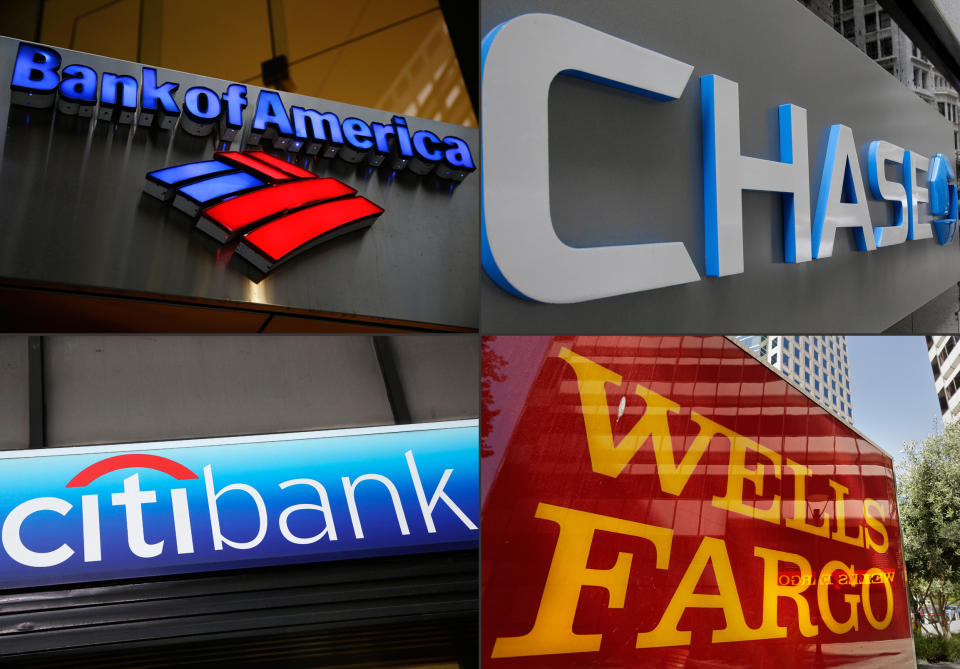Big banks are cautiously optimistic about the economic recovery
The four largest banks expressed optimism that the worst of the COVID-19 impact on the U.S. economy is behind them, hoping that a recovery should provide a positive boost in coming quarters.
JPMorgan Chase (JPM) and Citigroup (C) kicked off earnings season on Tuesday, with Bank of America (BAC) and Wells Fargo (WFC) reporting on Wednesday.
All four reported year-over-year declines in net interest income, the amount of money made off of bread-and-butter banking businesses like consumer and business loans.
The big banks had expected interest income to lose steam after the Federal Reserve lowered rates to near-zero in March. But with six months to digest the impact of the Fed’s cuts, the heads of the megabanks hope that a brighter economic outlook will make the lackluster third quarter results a bottom.
“We think we've reached a trough in [net interest income] and we should begin to see NII move sideways or higher in subsequent quarters,” Bank of America CFO Paul Donofrio told reporters in a call Wednesday.
Citigroup management described the third quarter as a time of “stabilization.” Citi CFO Mark Mason told analysts Tuesday that net interest revenue will actually grow “as hopefully COVID diminishes a bit.”

All four banks significantly slowed growth in their provisions for loan losses in the third quarter, a key measure of the cushion that banks set aside to absorb any losses from uncollected loans.
In total, the four banks provisioned $5.0 billion in possible loan losses. For comparison, the same banks added an eye-popping $33.0 billion in provisions in the second quarter, the depth of the COVID-19 crisis.
At JPMorgan Chase, the level of reserves it had accumulated actually declined on a quarter-over-quarter basis. But CFO Jennifer Piepszak cautioned analysts not to read that as a guarantee for better credit quality in the near-term future.
“The reserve release was largely on portfolio run-off and changes in exposure in wholesale [loans], so not a reflection of a change in our outlook,” Piepszak said Tuesday.
Fixed income as an economic hedge
RBC Capital Markets bank analyst Gerard Cassidy told Yahoo Finance that the profitability of the bank stocks hinges on how well the economy holds up in the next six months.
“What’s really going to be the tale of the tape on the future for credit losses will be the strength of the fourth quarter and first quarter of the economy,” Cassidy told The Final Round on Tuesday afternoon.
For their part, the banks offered slightly brighter forecasts for the U.S. economy, suggesting that the banks may be able to begin releasing reserves in coming quarters.
But substantial uncertainty still surrounds the banks’ economic assumptions.
For example, Mason said Citigroup assumes some fiscal stimulus in the first quarter of 2021 as part of its improved forecast. But at Bank of America, Donofrio told reporters Tuesday that the bank did not add any assumptions of stimulus when it set its reserves.
In the nation’s capital, House Democrats, Senate Republicans, and the White House still appear to be at odds over a possible deal.
In the meantime, banks are leaning on non-interest sources of revenue for profitability. Banks with strong trading desks were able to play fixed-income markets in particular. Following impressive trading revenues in the second quarter, JPMorgan Chase and Citigroup delivered again in the third quarter with 6% and 18% year-over-year increases, respectively, in FICC (fixed-income, currencies, and commodities) trading.
Bank of America, which fell short of the street’s estimates on revenue, lagged behind and actually saw FICC trading revenues tilt down 2% year-over-year.
Wells Fargo also saw lower fixed-income trading results in the third quarter. The San Francisco-headquartered bank still faces a cap on asset growth after its string of reputational problems.
The bank’s bottom line was squeezed by elevated expenses, including $961 million in costs related to customer remediation.
Brian Cheung is a reporter covering the Fed, economics, and banking for Yahoo Finance. You can follow him on Twitter @bcheungz.
IMF projects less severe global recession in 2020, but 'uneven' recovery
Chicago Fed's Evans: Fed can 'provide more accommodation' with QE
Less-educated Asian Americans among hardest hit by job losses during pandemic
A glossary of the Federal Reserve's full arsenal of 'bazookas'
Read the latest financial and business news from Yahoo Finance
Follow Yahoo Finance on Twitter, Facebook, Instagram, Flipboard, SmartNews, LinkedIn, YouTube, and reddit.

 Yahoo Finance
Yahoo Finance 
